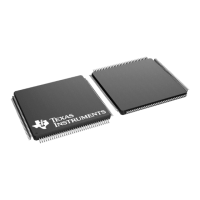www.ti.com
Device Level Interrupt Management
667
SPNU563A–March 2018
Submit Documentation Feedback
Copyright © 2018, Texas Instruments Incorporated
Vectored Interrupt Manager (VIM) Module
19.3.3 Software Interrupt Handling Options
The device supports three different possibilities for software to handle interrupts
1. Index interrupts mode (compatible with TMS470R1x legacy code)
After the interrupt is received by the CPU, the CPU branches to 0x18 (IRQ) or 0x1C (FIQ) to execute
the main ISR. The main ISR routine reads the offset register (IRQINDEX, FIQINDEX) to determine the
source of the interrupt.
This mode is compatible with the TMS470R1x (CIM) module and provides the same interrupt registers.
This mode could be used if legacy code needs to be reused, porting it from the TMS470R1x family.
However, imported software will not benefit from the VIM improvements.
To port legacy software, the interrupt vector at 0x18 (IRQ) or 0x1C (FIQ) only needs to be a branch
statement to a software interrupt table. The software interrupt table reads the pending interrupt from a
vector offset register (FIQINDEX[7:0] for FIQ interrupts and IRQINDEX[7:0] for IRQ interrupts). All
pending interrupts can be viewed in the INTREQ register. Example 19-4 shows how to respond to FIQ
with short latency in this mode.
2. Register vectored interrupts (automatically provide vector address to application)
Before enabling interrupts, the application software also has to initiate the interrupt vector table (VIM
RAM).
Once the VIM receives an interrupt, it loads the address of ISR from interrupt vector table, and store it
into the interrupt vector register (IRQVECREG for IRQ interrupt, FIQVECREG for FIQ interrupt).
After the interrupt is received by the CPU, the CPU executes the instruction placed at 0x18 or 0x1C
(IRQ or FIQ vector) to load the address of ISR (interrupt vector) from the interrupt vector register.
Example 19-3 illustrates the configuration for the exception vectors using this mode.
3. Hardware vectored interrupts (automatically dispatch to ISR, IRQ only)
Before enabling interrupts, the application software must initiate the interrupt vector table (VIM RAM)
pointing to the ISR for each interrupt channel.
After the interrupt (IRQ) is received by the CPU, CPU reads the address of ISR directly from the
interface with VIM (VIC port) instead of branching to 0x18. The CPU will branch directly to the ISR.
The hardware vectored interrupt behavior must be explicitly enabled by setting the vector enable (VE)
bit in the CP15 R1 register. This bit resets to 0, so that the default state after reset is backward
compatible to earlier ARM CPU. Example 19-1 shows how to enable the hardware vectored interrupt.
NOTE: This mode is NOT available for FIQ.
4. Software-Based Priority Decoding Scheme
If the application uses a software-based interrupt priority decoding scheme instead of the hardware
vector capabilities, then there is an additional step which was not required on earlier devices. This
version of the VIM will hold an interrupt request generated by a peripheral. When the software clears
the interrupt condition in the source module (for example, RTI, GIO, and so on), then it must also
perform an additional clear of the interrupt request in the VIM. This can be done by reading the
IRQVECREG register ( Section 19.9.15) or FIQVECREG register (Section 19.9.16), or by writing a 1 to
the INTREQ(i) bit (Section 19.9.10) in the VIM. This is not necessary if any of the three previous
methods are used as the interrupt request bit in the VIM will be automatically cleared when the vector
is read.
